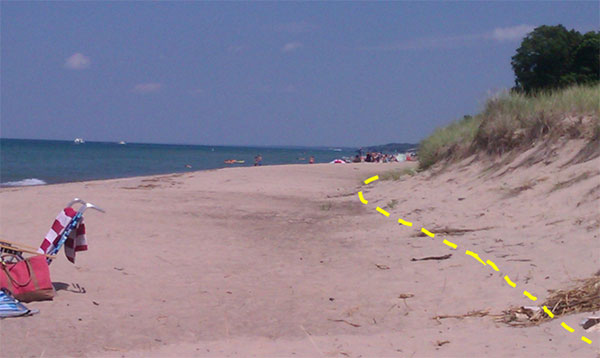Main Content
Article
Lake Michigan Ordinary High Watermarks
Lake Michigan is a navigable waterway, but it is the only Great Lake that is not also an international waterway. The bed of Lake Michigan is owned by the four states that share its shoreline: Wisconsin, Illinois, Indiana, and Michigan. Indiana holds the portion of Lake Michigan within its borders in trust for our citizens, but this trust is subject to the federal navigational servitude. Lake Michigan and its navigable tributaries are referenced in Navigable Waterways Roster .
The ordinary high water mark (OHWM) is the line on Lake Michigan and other navigable waterways used to designate where regulatory jurisdiction lies and in certain instances to determine where public use and ownership begins and/or ends.
The Indiana Administrative Code definition reflects the traditional common-law, or natural, OWHM as: The line on the shore of a waterway established by the fluctuations of water and indicated by physical characteristics. 312 I.A.C. 1-1-26(1). These physical characteristics include a clear and natural line impressed on the bank or shore, shelving, changes in the soil’s character, the destruction of terrestrial vegetation, or the presence of litter or debris.
In its February 14, 2018 ruling, Gunderson v. State, 90 N.E.3d 1171 (2018), the Indiana Supreme Court held that the boundary separating public trust land from privately owned riparian land along the shores of Lake Michigan is the common-law ordinary high water mark and that, absent an authorized legislative conveyance, the State retains exclusive title up to that boundary. As such, the Indiana DNR will apply the common-law OHWM when considering applications for construction activities along the Lake Michigan shoreline.
It is important to note that the physical location of the OHWM will move over time due to natural erosion and deposition (called accretion) of sand along the shoreline. This natural process will cause the DNR’s point of regulatory jurisdiction to change over time and, therefore, the DNR will verify the location of the OHWM on a case by case basis. At locations where an existing seawall is present and located lakeward of the OHWM, the DNR will consider the toe of the seawall as the OHWM for jurisdictional purposes.
Figure 1 provides an example application of the physical characteristics test to determine the location of the ordinary high water mark along the Lake Michigan Shoreline in Indiana.

Figure 1.
The dashed line on Figure 1 depicts the location of the OHWM based on the appearance of recognizable shelving at the toe of the dune bluff and the presence/destruction of terrestrial vegetation. In cases where the OHWM is not visible due to the discontinuous nature of the beach, the location of the OHWM will be verified through application of the physical characteristics test from nearby locations where the OHWM is visible.
